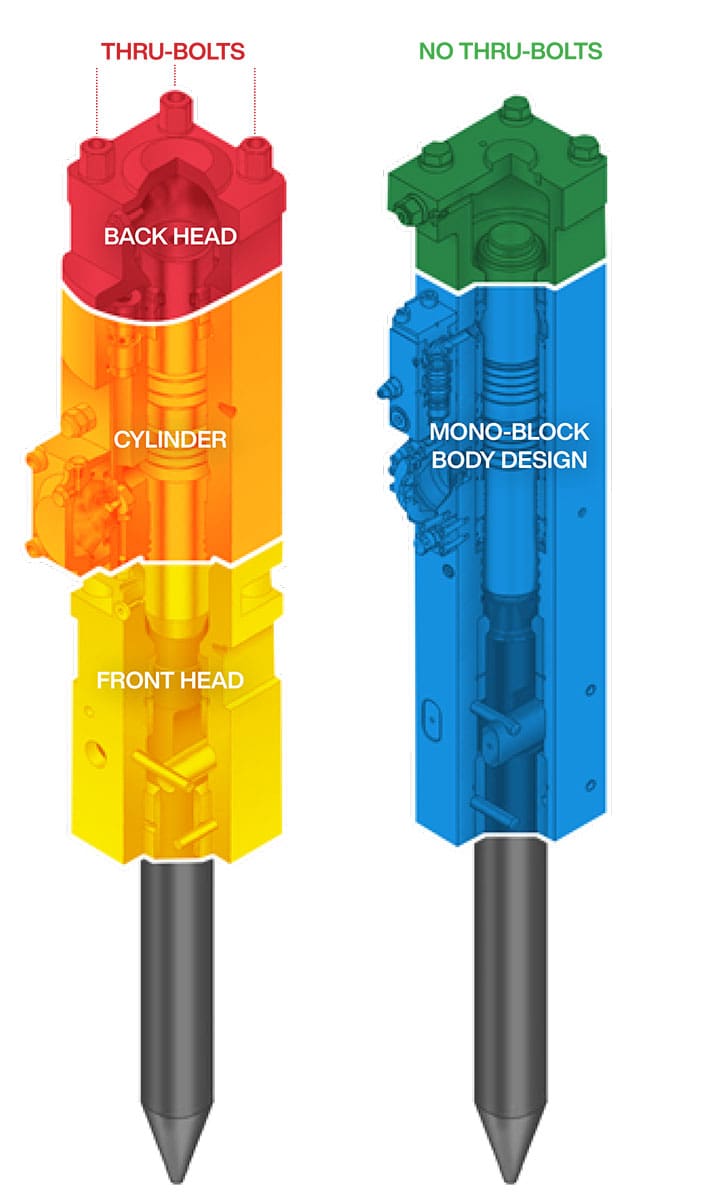Mono-Block Design Can Help Lower Breaker Life Cycle Costs
This blog post focuses on breaker design and the life cycle cost advantages associated with using fewer parts.
Hydraulic breakers involve a heavy piston striking a working steel, creating energy and using brute force to break material. That means breakers have to be strong, reliable and durable to stand up to the many stresses and harsh operating conditions they face. No matter how durable a breaker is, the repeated impacts they endure over time will lead to wear and eventual rebuilds, or in the worst case, the need for a new breaker.
There are several factors that can help extend breaker life, improve productivity and lower life cycle costs, from training operators so they follow proper operational standards to adhering to a routine daily, weekly, bi-annual and annual maintenance schedule to the design and construction of the breaker itself.
Typical Breaker Design
The industry standard for breakers typically has three primary components that are all tied together with thru-bolts, which are a maintenance item that needs to be periodically checked. The three components are:
- Back Head (nitrogen chamber)
- Cylinder
- Front Head
The back head is a nitrogen-filled chamber under low pressure that acts like a damper for the return piston stroke. The back head also serves to enhance impact when the piston travels down. The cylinder assembly primarily includes a cylinder, piston and control valve, and is the principal component of a hydraulic breaker. The piston and the valve are the only two moving parts of a breaker, with the piston moving to strike the working steel. The front head is where the piston connects with the working steel, which is retained with pins and is considered a common wear item.
Mono-Block Body Design
Incorporating the front head and cylinder into one piece, called a mono-block, is an alternate approach. Instead of requiring the front head and cylinder be held together with bolts, the two typically separate components are combined into a single piece of steel as the internal body of the breaker—which eliminates thru-bolts.
Without thru-bolts, that part of the maintenance schedule is eliminated and so is a point of potential failure. Routine maintenance and rebuilds will still be required, but overall maintenance costs and expensive downtime can be reduced with this type of design, while also lowering life cycle costs.
FRD USA manufacturers a wide range of breakers that feature a mono-block design, from small hydraulic breakers up to large breakers.
To learn more about FRD USA hydraulic breakers and how their mono-block body design can improve productivity and decrease costs, call FRD USA at 800.527.2282 or locate your sales rep.

Recent Posts
To learn more about FRD USA hydraulic breakers and how their mono-block body design can improve productivity and decrease costs, call FRD USA at 800.527.2282
Furukawa Rock Drill USA is a leading manufacturer of blast hole drills, hydraulic breakers and various other attachments for skid steer, mini excavators, backhoes and excavators. FRD USA Attachment Division (formerly marketed as Kent Demolition Tool) is a leading brand throughout North and Central America, and FRD USA Rock Drill Division offers a complete line of advanced drills and accessories for construction and quarry sites.